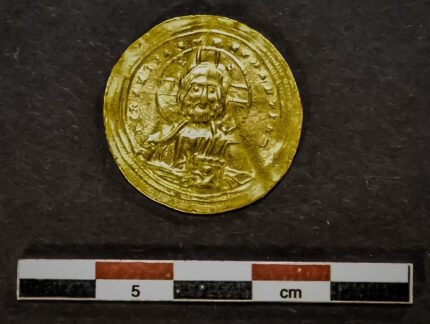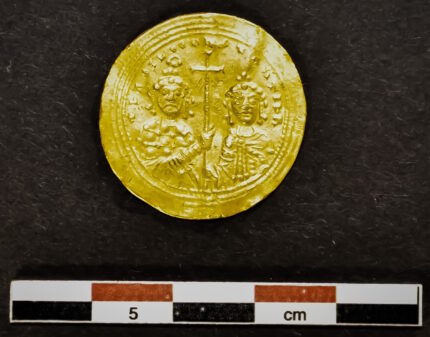A rare 10th century Byzantine gold coin has been discovered by a metal detectorist in Vestre Slidre, a ski town in the mountains of central Norway. It is in excellent condition, barely worn at all with no gold loss. It is the only one of its kind ever found in Norway.
The coin is a histamenon nomisma, the Byzantine solidus that was highly valued for its standard weight of 4.55 grams 24-carat gold, maintained consistently from the 4th century until the second half of the 10th century. The coin was minted in Constantinople, 1,600 miles from the find site.
The obverse of the coin depicts Christ Pantokrator (“Christ Ruler of All”), holding the New Testament in his left hand and raising his right hand in benediction. The reverse features the crowned facing busts of Basil II Porphyrogenitus on the left and Constantine VIII on the right, brothers who co-ruled the Byzantine Empire from 976 until Basil’s death in 1025. Basil wears the loros, a draped embroidered cloth symbolic of and exclusively worn by the imperial family. Constantine holds the Patriarchal cross between them. The Latin inscription on the obverse reads: “Jesus Christ, King of those who reign.” The inscription on the reverse reads: “Basil and Constantine, emperors of the Romans.”
County archaeologists speculate that the rare and valuable coin might have made its way to Norway with the heavy booty the future King Harald III, aka Harald Hardrada, carried home with him after a decade spent in the Varangian Guard of the Byzantine Empire. He had made large sums on the job, and after Prince Yaroslav in Kyiv, who had banked the gold for Harald, took his cut, Harald’s treasure-laden ships headed for Norway in 1046.
But how did the coin get to Vestre Slidre? Has it been lost on the way between East and West? We know that Valdres was part of the Bjørgvin diocese until 1125. And one of the older traffic routes is called Bispevegen. It is not impossible that the coin was lost by one of the clergy on their travels.
The old transport routes, the salt roads, were based on trade in salt from Western Norway, so it is also possible that the coin entered into a good trade between salt and herring from the west, and iron ingots, reindeer skins and antlers from the east.
The coin was found late this autumn, and weather prevented a follow-up excavation. Archaeologists will explore the find site when the field season begins next year.


“…He [Olaf II of Norway, 1015–1028] is said to have had divine zeal, by which he drove the evildoers out of Norway, who in number overflow the whole of Barbaria, as particularly Norway is full of such monsters. However, prophets as well as augurs and those, who conjure all the other companions of the Antichrist, do live there, by whose phonies and tricks hapless souls become the victims of Demons. All of them and those of their kind king Olaf ordered to persecute, in order to firmly coalesce the Christian faith with his realm by abolishing those scandals. Also, he had many bishops and presbyters from England with him, by whose advice and doctrine he prepared his own heart for God, and he commissioned to them his people for guidance. Among those of clear doctrine and virtue were Sigafrid, Grimkil, Rudolph [by 1050 back in Abingdon] and Bernhard. By order of the king, they were sent to Sweden, Gothland and all those islands that lay beyond Norway, to evangelize the barbars and bringing them the word of God and Jesus Christ. Moreover, he sent ambassadors with presents to our own archbishopric, wishing that our bishop [Unwan] would benignly host them, and likewise would sent his own to him, to comfort his crude Norwegian people in Christianity.”
Latin Source, and translated from: “Gesta Hammaburgensis”, Bk. II, ch55, written between 1073 and 1076AD
Why are texts in LATIN not accepted on here?!?
discovered when?
“…Dei zelum habuisse, ut maleficos de terra disperderet, quorum numero cum tota barbaries exundet, praecipue vero Norvegia monstris talibus plena est. …
(missing bit, apparently fileterd out) …Hos omnes et huiusmodi beatissimus rex Olaph persequi decrevit, ut sublatis scandalis firmius coalesceret in regno suo christiana religio. Habuitque secum multos episcopos et presbyteros ab Anglia, quorum monitu et doctrina ipse cor suum Deo praeparavit subiectumque populum illis ad regendum commisit. Quorum clari doctrina et virtutibus erant Sigafrid, Grimkil, Rudolfo et Bernard. Hi etiam iussu regis ad Suediam et Gothiam et omnes insulas, quae trans Nortmanniam sunt, accesserunt euangelizantes barbaris verbum Dei et regnum Iesu Christi. Misit etiam nuntios ad archiepiscopum nostrum cum muneribus, petens, ut eos episcopos benigne reciperet suosque ad eum mitteret, qui rudem Nortmannorum populum in christianitate confortarent.”
….I am not supposed to put the Latin bits about demons and the antichrist? 😀
😈️